Mission House Published in West Coast Modern
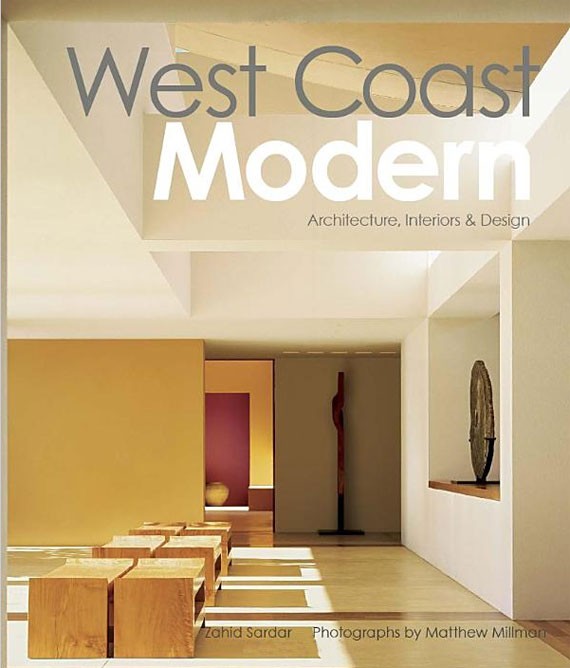
We’re pleased to announce that the Mission house has been published in West Coast Modern – a new architectural monograph by Zahid Sardar featuring “Breathtaking home designs that fit perfectly into the unique landscape of the West.” The book features work by offices such as Aiden Darling, Tom Kundig, Steven Ehrlich, and other notable names from California and the rest of the West Coast. San Francisco Live/Work – aka the Mission House – is on page 124 – the book is available for purchase on Amazon.
Saratoga Beach House Featured in The Province
We’re pleased to share that the Saratoga Beach House was published in The Province! The article recounts the construction and design of the newly completed home, including interviews with its owner and Andrew Dunbar of IA. You can read the article online.
Mission House Published in Houses Designed for Families
We’re pleased to share that the Mission House has been featured in Houses Designed for Famlies, a new architectural monograph published by Think Publishing. The book contains almost 50 modern homes designed with the family in mind, and you can find the Mission House on page 53.
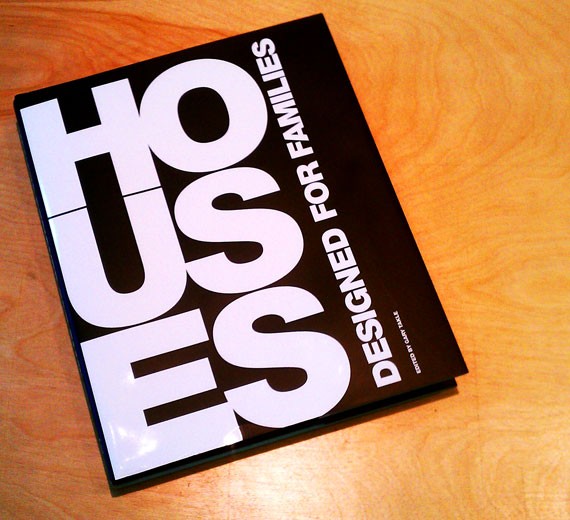
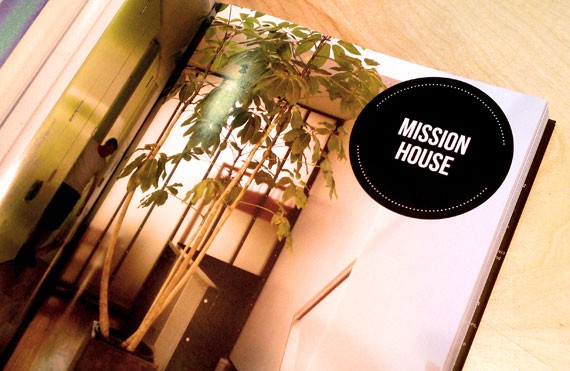
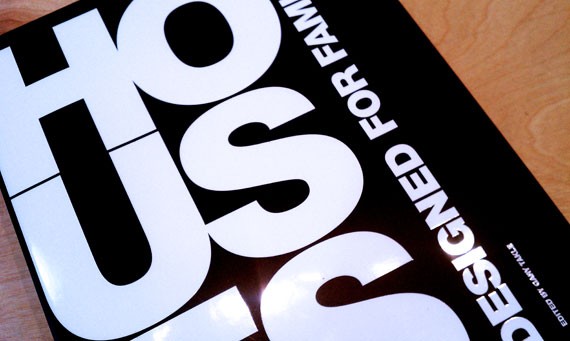
IA Workspace Featured in Residential Architect Magazine
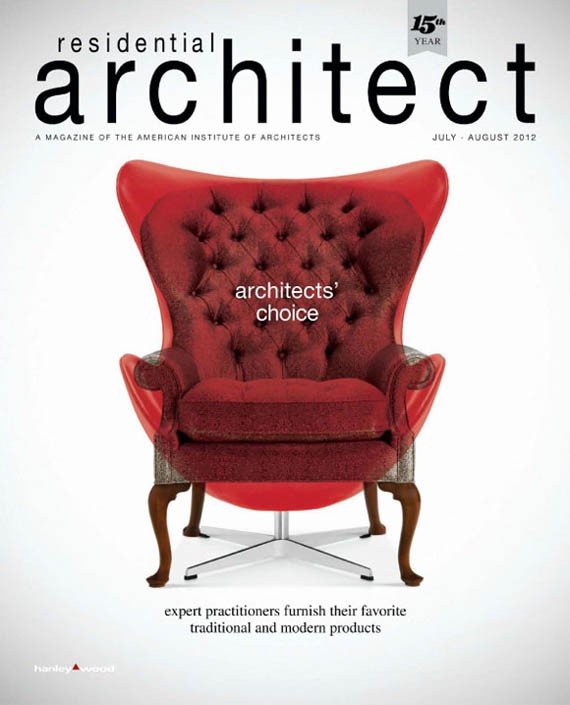
We’re pleased to share that this month’s Residential Architect includes a feature on IA’s warehouse workspace — turn to page 72 for the full story on the converted 1940’s era warehouse-turned-architecture office located in San Francisco’s Mission District. Also, be sure to check out IA’s Andrew Dunbar and Zoee Astrakhan’s video interview with Nigel Maynard of Residential Architect!
Bay Remediation Site: 1 Published in Landscape Architecture Magazine
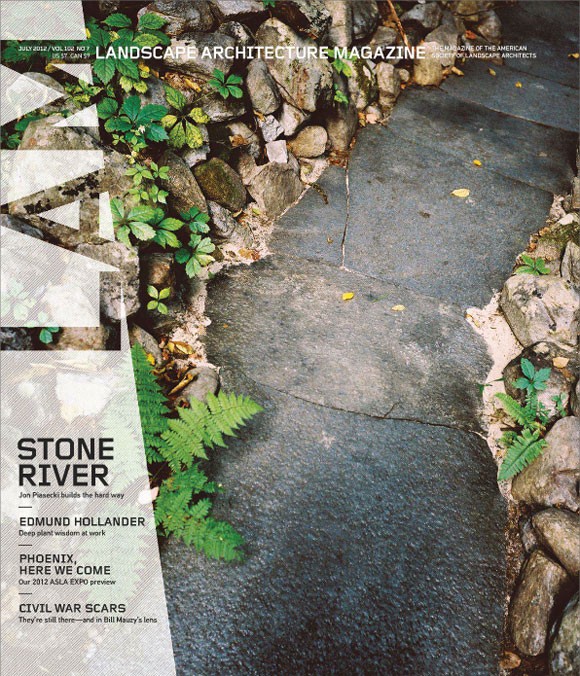
We’re pleased to share that our project “Bay Remediation Site: 1” has been published in on page 38 of this month’s issue of Landscape Architecture Magazine! The article features an interview with IA’s Andrew Dunbar and Zoee Astrakhan, and illustrates how the project investigates our office’s critical interest in blurring the lines between landscape, architecture, and infrastructure in order to create smarter systems that both rehabilitate our environment and create positive public spaces.
As discussed in the article, we believe there could be potential for projects such as BRS:1 to transition from the realm of theory to reality by gaining traction with local and state governments After the introduction of New York’s High Line, the collective interest of cities across the country to invest in green, urban, public spaces has been piqued. San Francisco is no stranger to this phenomenon – with the renovation of the SF/Oakland Bay Bridge being the city’s primary focus of a plethora of design proposals. As interesting as many of these ideas are, we believe that the project of “Green-Space-as-Destination-Infrastructure” could move beyond purely reclaiming derelict infrastructure for the purposes of tourism and urban revitalization.
Spanning hundreds of miles of coast line, “The Bay” is easily San Francisco’s most significant geographical characteristic – one that is deteriorating due to factors such as water pollution, environmental loss, and global climate change. We hope that BRS:1 can function as an in-road to discussing the potential benefit landscape infrastructure can have to creating destination green spaces that not only draw people and prestige to the city, but rebuild our coastal environment and foster community involvement and educational opportunities as well.
USF Center for Science and Innovation & Harney Plaza Featured in Architect's Newspaper
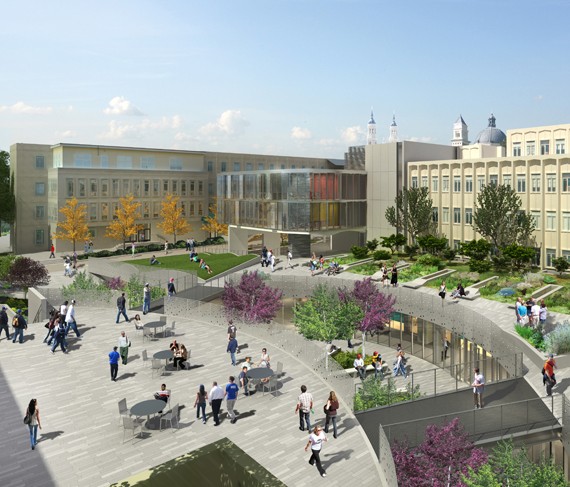
The Architect’s Newspaper’s January West Coast edition has published Interstice’s work on of the USF Center for Science and Innovation and Harney Plaza. In its feature article “Budding Relationships” (page 13), editor Sam Lubell discusses new approaches to building that merge landscape and architecture, and includes several new projects going up in California that follow the trend of “soil-meets-steel,” which has prompted “architects and landscape architects to collaborate more closely, and occasionally, even to reverse roles.” The USF CSI & Harney Plaza, which Interstice worked on in collaboration with NBBJ Architects, was included in the article’s trending survey of projects, as well as an interview with Interstice’s Zoee Astrakhan.
Recap – Home Tours Weekend/GREENskin in arcCA
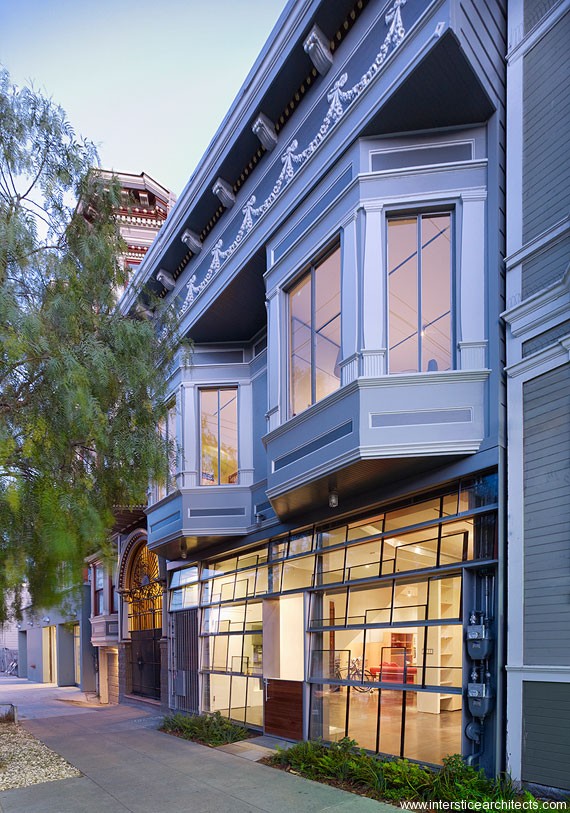
Photo: Mathew Millman
The Home Tours weekend and inaugural gallery installation went extremely well, and concluded a very busy month of September in the office. Now that we’ve had a bit a chance to catch our breath, we wanted to express our appreciation to everyone who participated in the Home Tours, and we were equally proud to share the Mission:House with all of you that took the time to drop by and see our work up close.
For those of you who weren’t able to make it to the Home Tours, you can read up on what some of our visitors had to say (Inhabitat / Architect’s Newspaper). Special thanks to Mike Chino (Inhabitat) and Lydia Lee (Architect’s Newspaper) for sharing their impressions!
On the topic of the Mission:House, we’re happy to share that our recently awarded GREENskin Facade System was featured in the 10.3 issue of arcCA, in its AIACC Design Awards Section. Flip to page 40 to see the project and other winning projects in the Small Design Category.
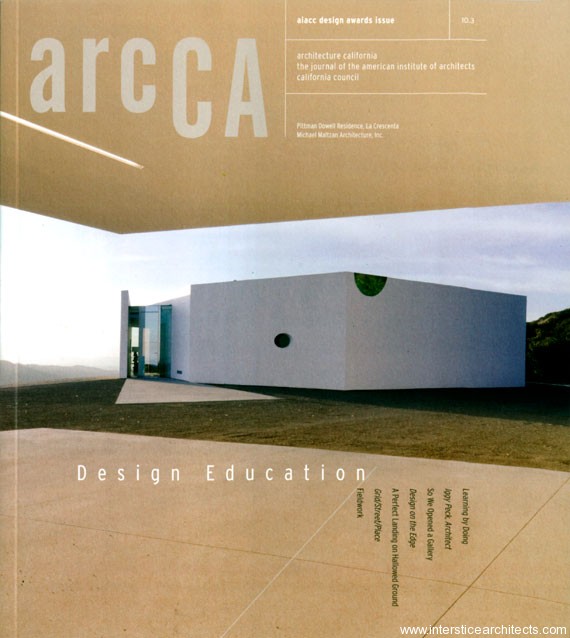
Agristructure | Ecostructure Featured in arcCA
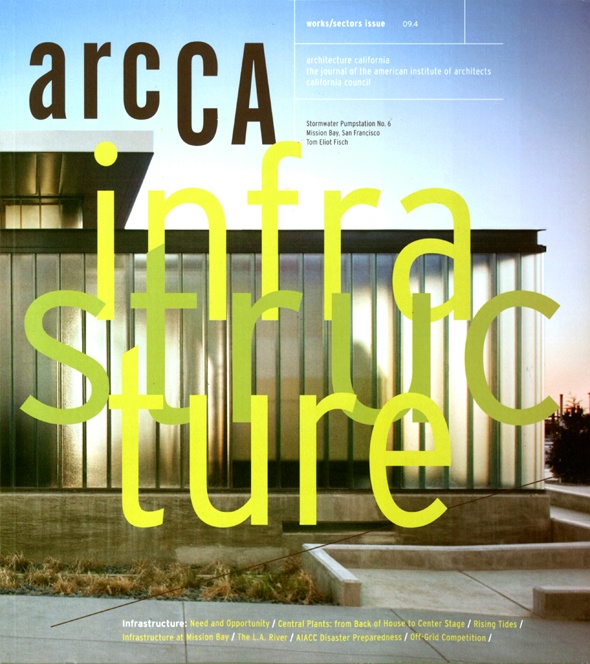
We are pleased to have our submission to the 2009 Off Grid 2.0 competition featured in the Works/Sectors Issue ( issue 09.4) of arcCA! Our project, titled “Agristricture | Ecostructure,” was awarded the Special Jury Commendation which in the words of the jury, “Was a very ambitious entry that explored teaching opportunities to a high degree … This solution is highly engaged in activities that support environmental learning.” The competition brief called for creative solutions to the remediation and redesign of Horseshoe Cove, a small ecological infill site that was once a marshland, drained and reclaimed by the military in the 1800s.

View of the New Horseshoe Cove from Kayak Launch
This project creates a high visibility public infrastructure that addresses the dynamic condition of the greater San Francisco Bay area ecosystem while creating a framework through which users may experience the ever changing local conditions of the site.
Given the increasingly complex shifts being brought upon Bay Area ecologies by global climate change, we believe that landscape itself can be a type of generative “soft” infrastructure, not only capable of fostering local remediation, but acting as an synthetically maintained ecological system which “seeds” other at risk ecological infill sites – re-establishing processes halted by years of development and environmental disruption.
Inspired by the research of Dr. Katharyn Boyer, the project’s two major functions are the replenishment of native eelgrass, and the production of critical natural resources to be used in a larger Bay-Wide remediation scheme.
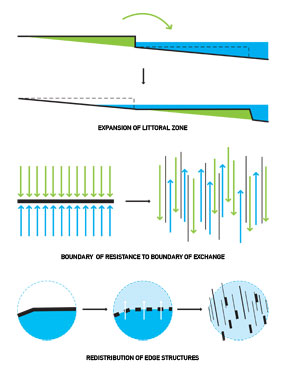
Site Strategy
This solution is initiated by first re-distributing the sea wall boundary, and transforming the site into a blurred tidal edge. We employ a series of simple performance typologies to create a sustaining landscape, and water/land ecologies evolve as we re-appropriate agricultural systems to create self-generating ecological structures. In shifting the context of these processes, we will also engender a transition from a culture of consumption to a culture of stewardship.
The site is organized and “grown” through the implementation of both Eco-structures and Agri-structures which create a highly concentrated wetland ecotone. These structures include redistributed land form, low-impact access catwalks, and distribution networks – together generating a site-wide “Plot” nursery for desperately needed habitats and endangered native species. The Plots are the biomass products of emergent wetland ecologies. The surplus production of the Plots is exported to other sites as they become available due to rising sea levels.
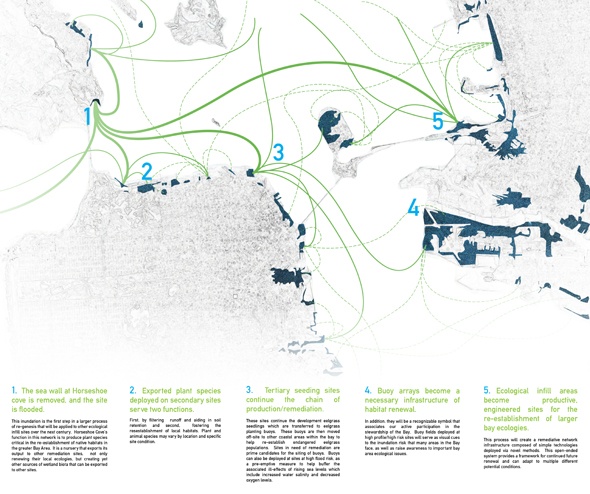
The "Remediative Network" - Mapping Potential Site Seeding
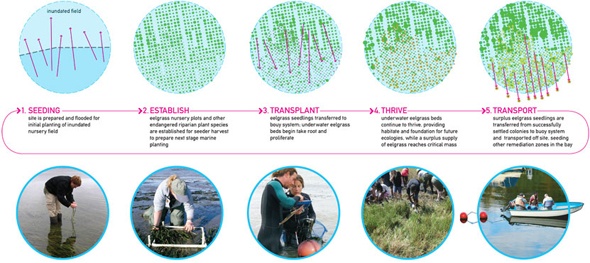
Eelgrass Cycle - Local Remediation Becomes Biomass Export
The simple flexible armatures, in turn, create program opportunities within the Plot nursery. The initial infrastructure recedes over time as proactive ecologies succeed. The Agri-structures remain, and are slowly reclaimed by the rising sea, eventually establishing a thriving marine estuary to become a destination for scientists, eco-tourists, and local residents alike. Our proposal is designed to remain perpetually unfinished, cultivating and capitalizing on emergent growth and flux, as the first node in an engineered remediation network of ecological and agricultural infill sites bay-wide.
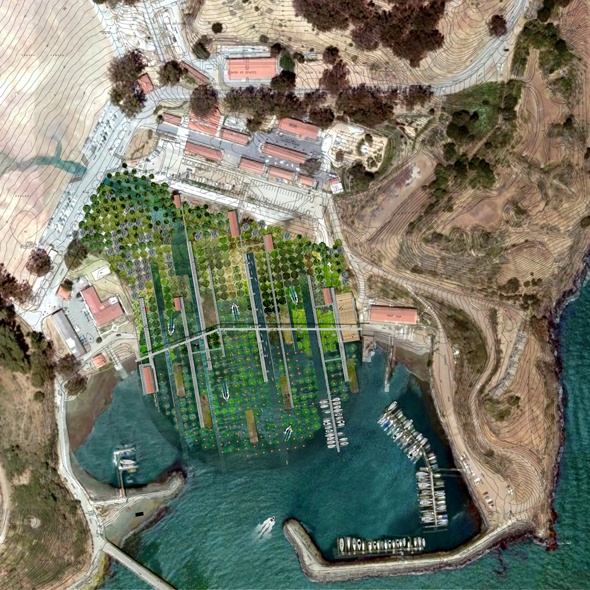
Plan - Ecological Infill or Productive Nursery?

Sections Through the Expanded Littoral Zone
Our design research for this project raised some topological questions regarding the role agriculture could play in ecological remediation, what the crossroads of infrastructure and natural systems might be like, the role of education in environmental design, and the true scales of impact local interventions could spark. These are by no means new questions, but given the current ecological and economic climate, we believe there is (or should be) a growing imperative towards open-ended, globally aware, locally sited design solutions. We want to rethink the idea of “public works” as a typically large, disruptive, and costly endeavor now replaced by smaller scale “soft” networks created through the exchange between a variety of fields, including architecture, landscape, environmental design, civil engineering, urban planning, logistics, social advocacy, and community leadership.
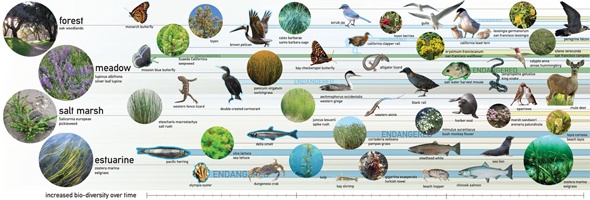
Ecological Web - Diversity Over Time
As we continue our research, we will document its progress on our blog – hoping to augment our findings through discussion and participation. We hope you enjoy putting forward whatever thoughtful insights, comments, criticisms, or resources you might have.
IA WINS TWO FIRST PLACE PRIZES IN 2011 GREENDOT AWARDS
Interstice Architects has won 2 first place prizes in the 2011 Green Dot Awards. IA placed first in the product design category for its GREENskin Facade System, and first place in the concept design category for the entry Bay Remediation Site: 1.
BURGER RESIDENCE FEATURED IN CALIFORNIA HOME AND DESIGN
The Burger Residence kitchen is featured in the July/August 2010 Issue of California Home and Design Magazine. This kitchen, featured on pages 118-119 of the issue, highlights the potential of a small space to create big impact in the connectivity between interior and exterior living spaces.
